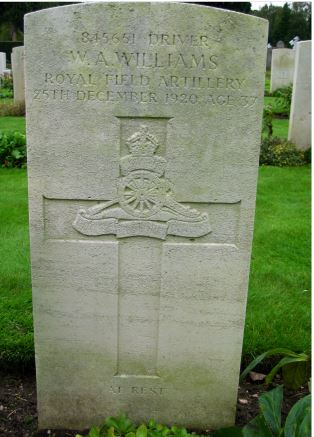2nd ‘C’ Reserve Brigade, Royal Field Artillery

Walter Andrew Williams was a Cornishman, born on 5 February 1884, at St Day, near Redruth, Cornwall. His parents were James Williams and his wife Annie. He was the eldest child of the family and had three brothers and two sisters.
By 1901 the family had moved to 19 Moor Street, Tredworth, Gloucester and Walter’s occupation at the time was as a ‘sawyer’s labourer’.
On 3 August 1901 Walter joined the Royal Navy and served on a variety of ships until 5 March 1908. In late 1906 he married a Devon girl, Lily Margaret Dymond, at Devonport. By the time of the 1911 Census the couple were living at 3 Georges Row, Morton Street, Tredworth and Walter was a machinist at the Gloucester Waggon Works. The census records them having had one child, who had died.
In 1912 Walter had a brush with the law. The Gloucestershire Echo of 16 December 1912 recorded his court appearance and a conviction for stealing a bicycle. He had hired a cycle, saying he needed it to get to work, which he later tried to sell in Warminster. He was given the option of paying a £1 fine or spending a month in prison: which choice he took is not known.
Unfortunately, no Army Service or Pension Record papers appear to have survived, which would have given a useful insight into the details of his service. However, conclusions can be drawn from such documents that have survived He has a Medal Rolls Index Card, which is normally a good indicator that he saw service abroad. This records that he initially joined the Royal Field Artillery (RFA) and was given the number 845651 and was posted to 2nd ‘C’ Reserve Brigade. His Silver War Badge (SWB) record (see below) shows that he enlisted on 14 January 1915. Following service with the RFA he transferred to 566th Home Service (HS) Employment Company, Labour Corps. The HS Employment companies undertook a variety of roles in the UK and generally a transfer to such a unit indicates that an individual had been down graded medically, due to wounds or sickness and no longer considered fit for front line service.
According to the SWB records Walter was discharged due to sickness on 4 June 1919. The badge was to be worn as an indictor that the wearer had undertaken military service and had been discharged.
A recently released Pension Record Card states that Walter’s death on 25 December 1920, age 37, was due to pulmonary tuberculosis and heart failure.
There is only a short funeral report in the Gloucester Citizen of 3 January 1921. The funeral was of a semi-military nature, with six RFA members acting as pall bearers, with representatives of the Pensions Advisory Council and Comrades of the Great War attended along with family and friends.
Driver Walter Andrew Williams is buried in Gloucester Old Cemetery, where a standard CWGC headstone (engraved with the RFA badge) marks the grave.
Researched by Graham Adams 7 March 2020
